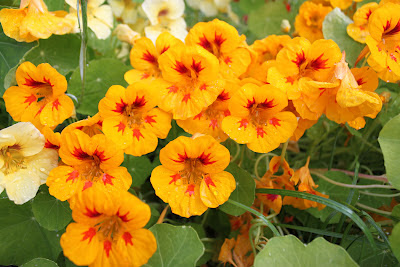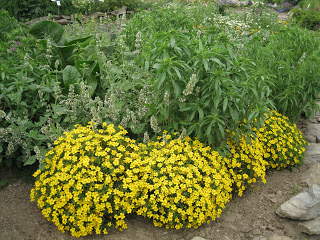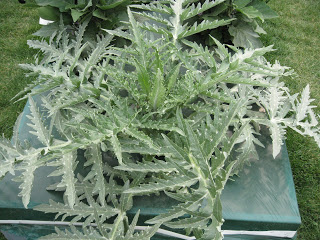A Lesson Plan for Gardening in Classroom in Alaska, By Amber Reece, An Alaskan Master Gardener
Subject Area: Art and Writing
Grade Level: Grade 3
Ideal Season For Lesson: Fall
 |
| Nasturtiums are a spicy, edible flower. Photo by Heidi Rader. |
Time to Complete Lesson: 90 minutes, divided into three activities
Materials Required:
Chart paper or other media for recording class discussions Hand drawn flowering squash poster
Prepared observation recoding forms (1 per student)
Assorted edible flowers such as nasturtiums, pansies, squash flowers, lilies, broccoli, cauliflower
Drawing paper and drawing supplies
Writing paper
Goal and Outcomes:
The students will use their five senses to examine edible flowers. Students will draw their flower. Student will write a descriptive paragraph about their flower. This lesson could be extended to include a research element and a larger writing project.
Teaching the lesson:
 |
| Tangerine Gems are also an edible flower. Photo by Heidi Rader |
Prior to teaching the lesson, the teacher prepares a poster of a flowering squash (or other) plant. The poster is hand drawn and shows the plant’s roots, stem, leaves, flower and fruit. The teacher also has a bouquet of live flowers and perhaps some vegetables (of which we eat the flower, see below). Pictures and posters of edible flowers will be a fruitful addition to this lesson. (Examples of edible flowers include: nasturtium, calendula, pansy, violet, rose, dandelion, clover, daylily dianthus, hibiscus, chive, broccoli, squash, most berry bush flowers, like strawberry, raspberry, blueberry, elderflower; fireweed, wild geranium, chickweed, chrysanthemum, honeysuckle, lilac, marigolds.)
Activity 1:
The lesson begins with the teacher displaying the poster. The teacher instructs the students to turn to their shoulder partner and name the parts of the plant. Which do they see/recognize? Which don’t they know about? Point out that some plants have big, obvious, colorful flowers, and some don’t. The students are given time to discuss the plant parts. Then the teacher refocuses the class on the poster and calls on the children to label the plant parts.
Activity 2:
Once the plant parts are labeled, the teacher asks the students what part of this plant (pointing at the poster) can you eat? The teacher records student responses on the bottom of the poster. Possibly the teacher has pictures of other plants (see below, whose flowers we can eat) If the class has not named eating the flower, or doesn’t realize that the part they eat is the flower, then the teacher imparts this knowledge to the students.
Of some plants, we can eat the leaves (lettuce, cabbage), others the stem (rhubarb), or root (radish, carrot), or flower. In fact in some cases, the vegetable we eat is really the flower or flower bud of the plant (artichoke, broccoli, cauliflower)! However, some parts of various plants can be poisonous to people and should not be eaten. Flowers that should not be eaten include: lupine, delphinium, monkshood. For this reason it is good to research before eating plants you don’t know, or even various parts of plants you do know!
The teacher asks students to share with their shoulder partner any other flowers the students can or do eat. After a turn and talk, the class shares their other edible flowers and the teacher records responses on the teacher’s preferred medium for recording responses. The teacher will add to the class lists to include the edible flowers the teacher is presenting for the class to examine.
Activity 3:
 |
| We eat the flower of an artichoke plant. Photo by Heidi Rader. |
The teacher explains to the class that they are going to be examining the provided edible flowers. The students are responsible for observing with all five senses and recording their observations on the provided observation sheet. The sight observation will be recorded on drawing paper. The student drawings will be pared with the student writing. The teacher explains that they will then draft a descriptive paragraph (or essay depending on grade level) about the edible flower. The descriptive paragraph must include observation from all five senses. (the sense of sound can derive from how the plant sounds when it is shaken, or if firm, how it sounds when squeezed or tapped on the desk) The class is informed that their writing and drawings will be displayed on the bulletin board in the hallway.
Curricular connections:
Art: Drawing is the portrayal of an idea using line and/or tone. Students will draw from nature using pencil and pen.
Writing: GLE [3] 1.1.2 The students writes about a topic by writing a paragraph on s single topic with two or more supporting details.
Extension activities:
Create a research paper with multiple paragraphs.
Writing: GLE [3] 1.1.3 Writing a composition with a beginning middle and end. Write a “how to’ composition for a recipe.
Writing: GLE [3] 1.5.1 The student documents sources or authors and titles of books and other materials when used as references in written work.
Cooking and science: The flowers can be prepared in a variety of ways to make them last or to make them more palatable. Some methods could be good gifts. For example, violets and rose petals can be sugared. Elder flowers and squash blossoms can be dipped in egg and flower and fried. Chives can flavor vinegar.
A Cautionary Note:
Be sure to learn and teach the students to not eat poisonous flowers and flowers that have been sprayed with pesticides. There are some confusing ones such as that sweet peas are not edible while pea flowers are.
Bibliography:
A “Starter Kit” of Edible Flowers for the Garden and Table
A Key to Flower Growing in Alaska (all flowers, not just edible flowers)
Growing Edible Flowers in Your Garden
About Heidi Rader
Twitter •